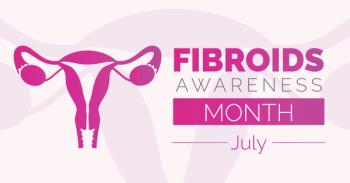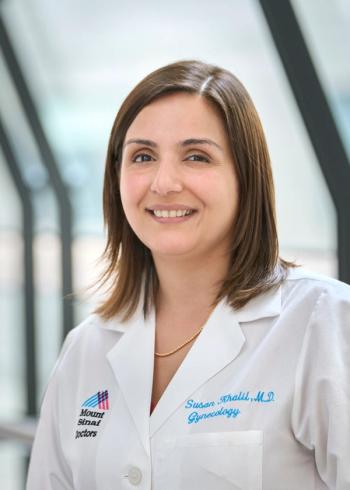
Approaching the Medical Management of Uterine Fibroids
Drs Mauricio Abrão and Jessica A. Shepherd provide insight on treating fibroids with nonsurgical treatment options for patients.
Episodes in this series

Mauricio Abrão, MD: Let’s move ahead and discuss the clinical options, Jessica. Tell me your thoughts about the role of estrogen and progesterone for fibroids, mainly because with the concepts related to the resistance to progesterone and the impact of progesterone in this trauma of the uterus, we need to think twice before deciding the medical treatment. Tell me your thoughts about this.
Jessica A. Shepherd, MD, MBA, FACOG: Absolutely. We’ve had so much expansion when we think of progesterone and its effect on fibroids. There’s progesterone as far as promoting growth of uterine fibroids and increasing the proliferation in cellular hypertrophy. How we look at the actual extracellular matrix of fibroids and knowing the progestin impact on that is an important part of how we might recommend progesterones from a medical management standpoint. Then also understanding that it can be a combination. We can have a combination of medical management with some procedures that can allow longevity when we think of the patient’s ideal of what they’re looking for from me, being from a bleeding perspective or a mass perspective from a bulk symptom.
Uterine fibroids being a common benign tumor, we still need to look at reliable long-term treatments that are available for patients. How do we explain that to patients? In the past, we have done the best that we can, when we think back to the 1940s and 1950s, with the advent of birth control pills and knowing that they were able to help with bleeding and how we were able to manipulate the hormonal impact. Now that we have progressed into having more of a progestin impact from a birth control or contraceptive standpoint, we still need to make sure that we’re understanding exactly how that has a cascade of events that lead to excessive extracellular matrix deposition from a progestin standpoint.
Understanding patients when they come with a preceding medical management that maybe they’ve failed is digging deep into what they’ve taken, how it has failed them, and then making sure we’re using our clinical judgment to understand that there may have been some hormonal effect and what we should stay clear of from that particular patient’s experience. With patients who haven’t experienced certain medical managements, we can use our clinical judgment and expertise to present that to the patient as a possible option for managing their periods and their bleeding from a fibroid.
Mauricio Abrão, MD: Jessica, you mentioned something that needs to be reinforced, that progesterones can stimulate the cell proliferation and the accumulation of the extracellular metrics, which can promote the development of the fibroids. There are some studies that very clearly show that a high dose of medroxyprogesterone acetate may even increase the growth of the fibroids, and we need to think twice before recommending these kinds of medications to patients. Even the intrauterine devices with progesterone may have this relation.
You gave a very nice summary looking for the indications of this combination of estrogens and progesterones for fibroids as a clinical management. Let me know your thoughts about SERMS [selective estrogen receptor modulators] in terms of these agents and if they could play in the treatment of the fibroids.
Jessica A. Shepherd, MD, MBA, FACOG: Typically, when we think of medications, we’re looking for things from the past that are going to manipulate the hormones to decrease bleeding. That’s usually when we think of contraceptives. But when we think of treatment of fibroids in a way that can potentially decrease the size of the fibroid without provoking a menopausal or a hypoestrogenic state, and also not creating more growth, like we were discussing with the progestin effect on the fibroid.
We have room for studies to look at how selective estrogen receptor modulators can reduce the size of fibroids and therefore impact the clinical symptoms that patients are having. We need more research. A fundamental standpoint that we should take during this discussion is that we need more research when we think of fibroids and their growth because there’s a large portion of fibroid growth that comes from a hormone-dependent standpoint. We may not know all of that at this time. We need more research that’s going to allow us to have a better manipulation or involvement of fibroids when we think of their growth patterns, their impact from a bleeding standpoint, and also how we can use medications, which we’ll get to when we talk about GnRH [gonadotropin-releasing hormone] antagonists, and how we can decrease the size of a fibroid and decrease additional growth.
These are tumors that have a propensity to grow in size like we’ve seen in many women who have significant growth in fibroids. But how do we impact in the way that’s going to improve quality-of-life factors and also improve it from a bleeding standpoint and even from a size standpoint? My summary would be that SERMS have some usefulness in the treatment of fibroids from a symptomatology standpoint. Then also, like you said, bringing that fertility aspect into the conversation as well. We have some good starting evidence, but we need to establish that more when we think of the benefit of SERMS in fibroid growth and quality of life. But we’re getting there, and I’m optimistic that we’re going to have even more to offer our patients in the upcoming years.
Mauricio Abrão, MD: I’m sure about that. But we also can’t forget the nonhormonal medical treatment for the disease because we have options like tranexamic acid for bleeding or even the nonsteroidal anti-inflammatory drugs that can reverse the relation with prostaglandins and create and reduce the bleedings associated with fibroids. Sometimes giving these medications is an additional option for this.
Transcript Edited for Clarity
Newsletter
Get the latest clinical updates, case studies, and expert commentary in obstetric and gynecologic care. Sign up now to stay informed.













